| |
|
 | |
| MaltaWildPlants.com by Stephen Mifsud |

|
| |
|
|
 |  |  |  |
| External Links: |
|
Chrozophora tinctoria (Dyer's Litmus) |
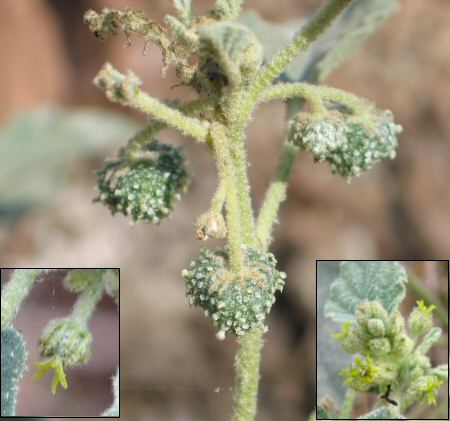
Chrozophora tinctoria (EUPHORBIACEAE.)
Images for this profile are taken from the Maltese Islands after year 2000. |
|
| Nomenclature |
Species name : | Chrozophora tinctoria (L.) A.Juss. | Authority : | Carl von Linne, Sweden, (1707 - 1778) ;
Antoine Laurent de Jussieu, France, (1748 - 1836) | Synonyms :
(basionym or principal syn.) |
|
Plant Family : | | English name(s) : | Dyer's Litmus, Turnsole, Croton | Maltese name(s) : | Turnasol | Status for Malta : | Indigenous. Present on the Maltese islands before man | Name Derivation : |
Chrozophora: Bearing staining properties. (Latin origin )
tinctoria: pigment or dye, with reference to pigments extracted from the fruit/seeds of the plant and used as an ink or to stain textiles. (Latin origin )
| Remarks : | |
|
| Morphology and structure |
PLANT STRUCTURE: |
Character | Growth Form | Branching | Surface |
Description | | | |
General
Picture |  |  | 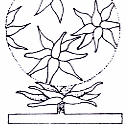 |
|
LEAVES: |
Character | Arrangement | Attachment | Venation |
Description | | | |
General
Picture |  | 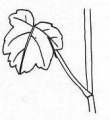 |  |
| |
Character | Leaf Shape | Leaf Margin | Remarks |
Description | | | Leaf Colour Ash-Green, easily spotted in its habitat. |
General
Picture |  | 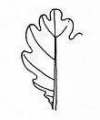 |  |
|
FLOWERS: |
Character | Colour | Basic Flower Type | No. of Petals | No. of Sepals |
Description | Yellow | | 5 (Referring to male flowers). | 5 (very small, less then 1mm wide). |
General
Picture | | 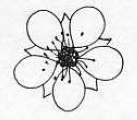 |  |  |
| |
Character | Inflorescence | Description | Ovary | Stamens |
Description | | The male and female flowers are very small (1 mm) and so inconspicuous. The male flowers have 5 yellow petals and a cluster of 5 black anthers at the centre. The female flowers have no petals, only a globular ovary (enclosed by 10 sepals) with 3 yellow styles that each split into two. | | |
General
Picture |  |  |  | 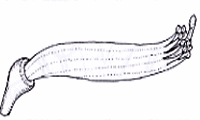 |
| |
Character | Scent | Average Flower Size | Pollen Colour | Other Notes |
Description | None | 1-2mm | Pale Yellow | - |
|
SEEDS: |
Character | No. Per Fruit | Shape | Size | Colour |
Description | 3 | Ovoid to Teeth shaped Shape is more or less oval but cross-sectional circumference has angular edges (hence not perfectly round). Seed possess a blunt tip. | 4mm | Beige |
General
Picture |  |  |  |  |
|
FRUIT AND OTHER BOTANICAL DATA: |
Character | Fruit Type | Colour of Fruit | Subterranean Parts | Other Notes |
Description | | Dark Green (with white spots). | | - |
General
Picture | 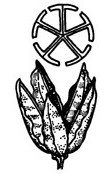 |  |  |  |
|
|
| Plant description and characters | |
Life Cycle: | Annual. |
Growth Form: | THEROPHYTE (annual plants, herbaceous) |
Habitat: | Dry fields and wasteground. Common in fallow fields too. |
Frequency: | Frequent |
Localities in Malta: | Found in the valley bed of Wied il-Qlejgha (Chadwick Lakes) and some nearby fields/wasteground. Also found in fields and in disturbed ground at Marsascala. |
Plant Height: | 30-50cm. |
| Jun-Sep |
Protection in Malta: | Not legally protected till the last update of this website (2/Mar/2022) |
Red List 1989: | Not listed in the Red Data Book of the Maltese Islands |
Poison: | |
The plant has an ash-gray green appearance, because it is densely covered with white, wool-like (tomentose) hairs. The hair is described as stellate (star-shaped) since groups of hair bristles are arranged as radiating out from a common point and so they have the shape of a pointed star. The plant produces few simple branches starting at least one third up of the plant height. The basal stem is thin and yellow-amber in colour.
Leaves grow alternately along the stem and are not found in large numbers per plant. The mature leaves have a long petiole (longer than the
leaf length) and a rhombic to ovate shape. Leaf margins are sinusoidal (wavy) in a perpendicular plane to the lamina plane.
The plant is monoecious hence producing male and female flowers separately, which both are tiny (1-2mm) and therefore inconspicuous. The male flowers have a 5-sepal calyx, 5 yellow petals and a cluster of 5 central stamens which have dark or black anthers. The female flowers
have a 10-sepal calyx around a spherical ovary, no petals and 3 styles which each subdivide into 2 stigma. The male and female flowers outgrow as
a raceme at the top of the branch, but they are so densely packed that appear to be a spike. Male flowers are above the basal female flowers in the spike-like raceme. Flowers are pollinated by a small-sized species of ants.
Without doubt, the most conspicuous part of the plant is its fruit. The fruit is a strange looking capsule with the shape of 3 spherical bodies
fused in a rather rounded-triangular structure. Additionally the fruit has perpendicular stubby projections and white scales contrasting with the dark green wall of the fruit. Each fruit holds 3 seeds.
When reaching full maturity, the fruit darkens to a dark green colour and eventually burst open with an incredible strong and sudden twist of its walls, sending the seeds inside to a considerable distance away. The seeds are oval or teeth shaped with a rough texture. They are 4mm in size and grey to light brown colour. The remnants of the fruit wall (found on the soil under the plant) rapidly turn black.
|
|
| Information, uses and other details |
Distribution:
This plant is mainly found in the Mediterranean region and central/south Asia. It is described as Native to the following countries: [WWW-26]
Africa: Algeria; Egypt; Libya; Morocco; Tunisia; Yemen (Socotra).
Asia Temperate: Kuwait; Saudi Arabia; Yemen, Afghanistan; Cyprus; Egypt (Sinai); Iran; Iraq; Israel; Jordan; Lebanon; Syria; Turkey.
Soviet Middle Asia: Kazakhstan; Turkmenistan
Asia Tropical: India (Jammu and Kashmir), Pakistan
Europe: Ukraine incl. Krym; Albania; Bulgaria; Greece incl. Crete; Italy incl. Sardinia & Sicily; Malta; Yugoslavia; France incl. Corsica; Portugal; Spain incl. Baleares.
Found in most Mediterranean and Middle Eastern countries, it is a naturalised weed in Australia, particularly WA and SA and has been reported in the North American states of Alabama and Maryland [WWW-110]
Edible Uses:
Edible red and blue dyes are obtained from the flowers, fruit and sap [61].
It was used to give extra colour to hippocras and other compounded wines: 'With the seed of the smaLl Tornesoll - . .' wrote Henry Lyte in 1585 , 'they dye and stayne old linnen cloutes and ragges into a purple colour wherewithall in this countrey, men use to colour gellies, wynes, fyne confeciones and comfittes.' [WWW-106]
Turnsole was considered as another kind of Litmus and sometimes was used for coloring Dutch cheese [338] and certain liquors [WWW-18]
Medicinal Properties:
This plant is reported to have the following medicinal properties [WWW-66]:
| Cathartic |
Cleansing the bowels; promoting evacuations by stool; purgative. [WWW-32] |
| Emetic |
An agent that causes vomiting, so as the stomach is emptied from its contents. [WWW-57] |
| Fever (Febrifuge) |
A medicine that lowers body temperature to prevent or alleviate fever [WWW-32] |
| Wart |
Used to control and treat warts [SM] |
Colouring Properties and its historical use as a colourant
Chrozophora tinctoria: a mediaeval colorant in the seventeenth century.
Most organic colourants in mediaeval manuscript illuminations are the result of metallo-organic complexation: the organic substance (antraquinone, flavonoid) is precipitated with a metal (Al, Fe, Sn) salt into an insoluble pigment lake. Sometimes miniature painters used very specific different colourants in a pure and uncomplexed form, known as clothlets. Coloured juices were expressed from seed kernels, berries or flowers and pieces of cloth were dipped into it. When enough of the colouring substance was taken up, the clothlet was dried and stored. For use a small piece was wetted so that the colour dissolved out of the clothlet and into the medium. This water colour paint was used for thin translucent washes. [WWW-103].
In Turkey it has long been used as a source of dye for Turkish carpets and in Palestine is used, much like henna, to dye the fingernails. It grows on dry fallow land, amongst crops such as wheat or onions, and in vineyards. [WWW-110]
Different botanical sources and their colouring components could be used for this purpose. The most important of these is Chrozophora tinctoria Juss. This greyish-green annual, belonging to the Euphorbiaceae, has found description in several mediaeval technical treatises. It is generally thought that Chrozophora clothlets ceased to be used with the ascend of the bookprinting industry after C16th. However, a fairly late C17th manuscript contains a wealth of Chrozophora recipes. [WWW-103].
C. tinctoria is cultivated in France, confined to a village named Grand-Gallargues, in the neighborhood of Nimes. The greenish juice in contact with ammoniacal liquids yields a kind of litmus, which turns red by acids, but does not become blue again under the influence of alkalies. Paint rags are made by dipping pieces of muslin into the juice and exposing them to the ammoniacal vapors arising from a mixture of urine and lime, or from, horse-dung, until the desired color is produced. This material is stated to be mostly exported to Holland, where it is used for the coloring of cheese and of certain liquors. [WWW-18]
Chrozophora Tinctoria is a dye plant native to Syria used as an illuminators pigment and as a Blue food colouring. It was sold commercially in Europe for staining "clothlets" or Rags. The term Turnsole came to mean any such rag used as a colouring agent whether the original source of colour was the herb Turnsole or someother source such as Woad, Cochineal or grape juice. [WWW-104] M. Webster online dictunary [WWW-105] defines turnsole as an a European herb (Chrozophora tinctoria) of the spurge family with juice that is turned blue by ammonia; also : a purple dye obtained from it.
Turnsole is a purple dyestuff, formerly much used as a food colouring, especially for jellies. It is obtained from the fruits of Chrozophora tinctoria L., a member of the spurge family native to the Mediterranean. The green juice of the fruits was pressed out with a roller and coarse linen rags were allowed to soak it up. These were dried, and on exposure to air or ammonia fumes, turned a beautiful purple colour. Turnsole was once much cultivated in the South of France, but is rarely met with in modern times, due to the widespread use of synthetic dyes. [WWW-106]
One document also states the implication of C. tinctoria in the Bible as a dye. Leshishit (turnsole, Chrozophora tinctoria) grows wild among the summer crops in many parts of Israel. The various parts of this flowering plant produce a blue dye which is used for dyeing textile. From Biblical Israel this dye eventually reached Europe where it is used for coloring food to this day. [WWW-107]
Toxicity
Few reports such as those stated by the US Food and Drugs Administration [WWW-23] indicate that the plant have toxic properties to some farm animals and even to man. {See list here). Furthermore, a document itiled "Sand Dune Vegetation of Cholistan (Pakistan) and Some Control Measures Against Wind Erosion", written by Dr. Mirza Hakim Khan list Chrozophora tinctoria as an unpalatable poisonous plant and needs attention for its control. (Click here to read full document). Toxicity evidence on this plant needs to be fortified by more reasearch work.
Botanical description of the genus Chrozophora
Chrozophora Neck. ex A.Juss., Euphorb. Gen. (1824) 27 ('Crozophora'), nom. & orth. cons.; Mull.Arg. in DC., Prodr. 15, 2 (1866) 746; Pax & K.Hoffm. in Engl., Pflanzenr. IV.147.vi (1912) 17; Prain, Bull. Misc. Inform. (1918) 49; Airy Shaw, Kew Bull. 26 (1972) 232; G.L.Webster, Ann. Missouri Bot. Gard. 81 (1994) 73; Welzen, Blumea 44 (1999) 419; Radcl.-Sm., Gen. Euph. (2001) 151. --- Type species: Croton tinctorium L. (= Chrozophora tinctoria (L.) A. Juss.) [WWW-108]
Herb or undershrub, monoecious. Indumentum consisting of very dense, sessile and peduncled stellate or lepidote hairs, next to simple hairs (latter mainly on lower leaf surface). Stipules narrowly triangular, tomentose, caducous, scars very indistinct. Leaves spirally arranged, simple; petiole not pulvinate, reniform in transverse section; blade ovate, often 3-lobed, coriaceous, symmetric, margin shallowly to laxly but distinctly crenate, apex rounded, upper surface less densely covered by hairs than lower surface, the latter usually basally with 2 glands near insertion and often with submarginal glands, glands crater-like (circular, rim-like wall, concave inside); venation basally trinerved, pinnate along midrib with nerves ending open in the margin, veins laxly scalariform, quaternary veins reticulate. Inflorescences terminal racemes (in fruit pseudo-lateral and opposite to leaf due to extension of axillary buds), solitary (or 2 together), not branching, basal flowers pistillate, apical ones staminate; rachis tomentose. Bracts narrowly triangular, only hairy outside.
Flowers actinomorphic, staminate flowers usually 2 per node, pistillate flowers usually single; pedicels with abscission zone; calyx 5-lobed, valvate, tomentose outside, glabrous inside; petals 5; disc indistinct, glabrous. Staminate flowers subsessile; calyx campanulate, lobes ovate; petals slightly larger than sepals, obovate, petaloid, margin in upper part undulate, with simple hairs on both sides; disc divided into small glands, united with petals; stamens 13--16, glabrous, filaments united into a column, branching off in c. 3 layers, free part thread-like, anthers basidorsi-fixed, 4-locular, opening extrorse with lengthwise slits; pistillode absent. Pistillate flowers pedicellate; calyx and petals persistent, both 5-merous, narrowly ovate, hairy outside, glabrous inside, petals sepaloid in texture, slightly smaller than calyx; disc annular, very flat; pistil 3-locular, on short gynophore, one ovule per locule, smooth, covered by flat stellate hairs; style short, hairy, persistent; stigmas almost completely divided, below stellately hairy, above with long slender papillae, persistent. Fruits slightly lobed capsules, triangular in transverse section, dehiscing usually septicidally and partly loculicidally into 3 bivalved parts, outside densely stellate, inside glabrous, thin-walled; column slender, with frayed remnants of the septa, apically triangular; septa single veined?. Seeds 3 per fruit, obovate, angular; covered by a thin, incomplete sarcotesta; the latter carunculate apically. Embryo flat; endosperm copious. [WWW-108]
Distribution: Eleven species from Africa and the Mediterranean through SW and S Asia to SW Asia. In Malesia a single species, probably accidentally introduced [WWW-108]
An Investigation on Chrozophora tinctoria distributed in West Anatolia
The morphological characteristics of the root, stem, leaf, flower, seed and fruit of Chrozophora tinctoria (L.) Rafin. (Euphorbiaceae) distributed in West Anatolia were determined, and biometric measurements were taken from samples collected from 42 different localities. This plant is a monoecious, annual herb, 28-63.50 cm. and stellate hairy. Its leaves are alternate and their shapes vary from rombic-ovate to ovate-lanceolate. The leaves are bifacial and amphistomatous. Their stomatas are of the amaryllis and parasitic types. The development of the root, stem, and leaves of the plant were observed when grown under various fertilizer, soil, lime and watering conditions, and their biometric measurements were taken. The plant did not show any sign of growth or development under shade and lime conditions. Fertilizer inhibited growth and development of the root while stimulating the stems and leaves. IBA and Pokon hormones were not effective in vegetative propagation. The plant grows under various conditions at altitudes of 0-1650 m. [339] ( Click here to read full pdf document)
Personal Observations
Plant of Misnomers
This plant is often called as the Turnsole which happens to be the same 'official' name used to describe the plant Heliotropium europeaum that forms part of the Borage family. [SM]
The Arabic name "Faqqoos el-homaar" and the Turkish "Akbas" are normally applied to Chrozophora tinctoria (L.) A. Juss. [WWW-111], [WWW-110]. In Malta, strangely enough, the name "Faqqoos el-homaar" or as locally written - "Faqqus il-Hmir" is a name given to Ecballium elaterium (Squirting Cucumber) which belongs to Cucurbitaceae, a completely different family from Euphorbiaceae that Chrozophora belongs to. [SM]
The genus name is also found reported under the name Crozophora instead Chrozophora [SM]
|
|
| Links & Further literature
(0 papers) |

Google Web |

Google Images |

Google Scholar |

Research Gate |

Wikipedia |

JSTOR |

GBIF |

Med Checklist |

Cat. of Life |

EoL |

IPNI |

World Flora Online |

Plants of the World Online |

Vienna Virt. Herb. |

RBGE Herbarium |

KEW Herbarium |

MNHN |

Arkive |

IUCN |

CABI |
Kindly Email if there are papers and publications about local
studies or information about this species to be included in the list above.
|
| Photo Gallery (36 Images) |  |
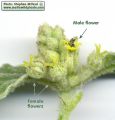 |
 |
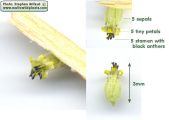 |
IMAGE: CRZTN-01 Photo of flower cluster which consist of a dense spike-like raceme of male (staminate) and female (pistillate) flowers.The flower close to the ants is the male while the rest are all female. |
IMAGE: CRZTN-02 Scanned image of inflorescence indicating the tiny male and female flowers. Note the black anthers and tiny petals of the male flower. |
IMAGE: CRZTN-03 Close up photo of male flower in situ. Flower size not more than 2mm across. |
IMAGE: CRZTN-04 Scanned image of male flowers. Apart from the 5 visible stamens there is another row of 5 stamens inside the corolla tube. |
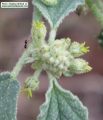 |
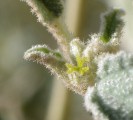 |
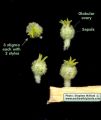 |
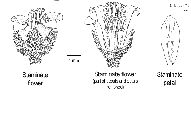 |
IMAGE: CRZTN-05 Photo of female flowers in situ. |
IMAGE: CRZTN-06 Photo of a female flower having 3 V-shaped pistils. Note the numerous stellate hairs covering the flowers and young leaves. |
IMAGE: CRZTN-07 Scanned image of female flowers against a dark background. Each tiny (=2 mm) flower consists of a globular ovary, and 3 yellow, V-shaped pistils. |
IMAGE: CRZTN-08 Illustration of staminate flower of the Chrozophora species (image by Jan van Os). |
 |
 |
 |
 |
IMAGE: CRZTN-09 Illustration of pistillate flower of the Chrozophora species (image by Jan van Os). |
IMAGE: CRZTN-10 Photo of plant (bottom right) in its habitat. Here it is at the bottom of a water course that is dry during most of Summer. |
IMAGE: CRZTN-11 Photo of a young plant. Note how off-ground the branching and leaves are. Could be also symptoms of etiolation since this place is quite (but not fully) in shade. |
IMAGE: CRZTN-12 Photo of a young plant, already bearing fruit. |
 |
 |
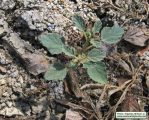 |
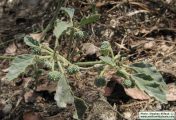 |
IMAGE: CRZTN-13 Photo of another plant which forms branches and leaves have a long petiole. |
IMAGE: CRZTN-14 Photo of plant showing leaves and fruit. Old and dried-up flower raceme at the top. |
IMAGE: CRZTN-15 Photo of the plant in its habitat. |
IMAGE: CRZTN-16 Photo of another plant in situ. As it can be noted flowers are inconspicuous. |
 |
 |
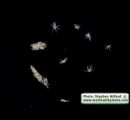 |
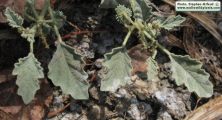 |
IMAGE: CRZTN-17 Photo of an adult plant which reaches up to 50cm in height. |
IMAGE: CRZTN-18 Close up photo of stem showing clearly a distinctive characteristic of this genus, that is the stellate (star shaped) hairs. These hairs make the plant look greyish-green. |
IMAGE: CRZTN-19 Magnified scanned image of the stellate hairs. (<1mm!). |
IMAGE: CRZTN-20 Photo showing several leaves which are attached to stems by a long petiole - longer than the leaf length. |
 |
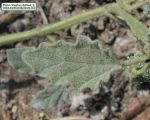 |
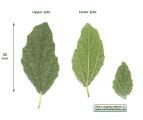 |
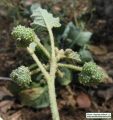 |
IMAGE: CRZTN-21 Close up photo of leaf which has a rather rhombic-ovate shape, undulate (wavy) outline and well visible pinnate venation. |
IMAGE: CRZTN-22 Photo of a young leaf showing clearly the undulate outline. |
IMAGE: CRZTN-23 Scanned image of some leaves (part of the petiole is removed). |
IMAGE: CRZTN-24 Photo of plant bearing its characteristic fruit. |
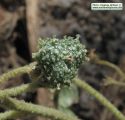 |
 |
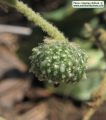 |
 |
IMAGE: CRZTN-25 Close up photo of lower face of fruit. It is rather triangular in shape with 2 knob-like corners. Each 'knob' holds a seed inside. |
IMAGE: CRZTN-26 Close up image of fruit showing well the perpendicular whitish projection and scales at the fruit wall. |
IMAGE: CRZTN-27 Side view photo of fruit. |
IMAGE: CRZTN-28 Another photo of the fruit which is a loculicidal dehiscent capsule, that is it opens up by splitting longitudinally. |
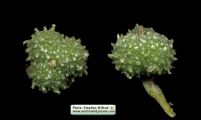 |
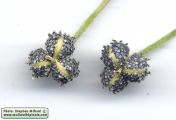 |
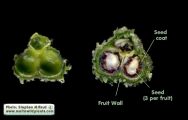 |
 |
IMAGE: CRZTN-29 Scanned image of 2 fruits (lower side & lateral view). |
IMAGE: CRZTN-30 Scanned image of fully ripe fruit. This is indicated by the fact that the fruit wall becomes dark green and finally black. The fruit splits with a sudden twist and a 'clicking' noise and disperses the 3 seeds to a considerable distance. |
IMAGE: CRZTN-31 Scanned and annotated image of a cross section dissection of a mature fruit. Inside wall glabrous. |
IMAGE: CRZTN-32 Scanned image of seeds, teeth like and with rough texture. |
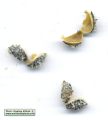 |
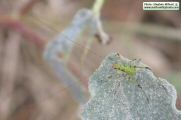 |
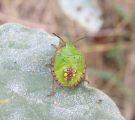 |
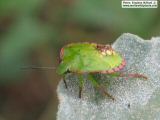 |
IMAGE: CRZTN-33 Walls of a split fruit. |
IMAGE: CRZTN-34 Photo of an insect found on the leaves of the plant. |
IMAGE: CRZTN-35 Photo of a bug found on this plant during photography. This insect is a nymph of a Green Vegetable Bug, Nezara viridula. |
IMAGE: CRZTN-36 Another photo of Nezera viridula. only the nymphs of this species seem to have the vibrant coloration on their backs. The markings tend to fade out as they change their exoskeleton to grow further, leaving the adults with faded markings, or nothing at all, just green. |
|
| | |

